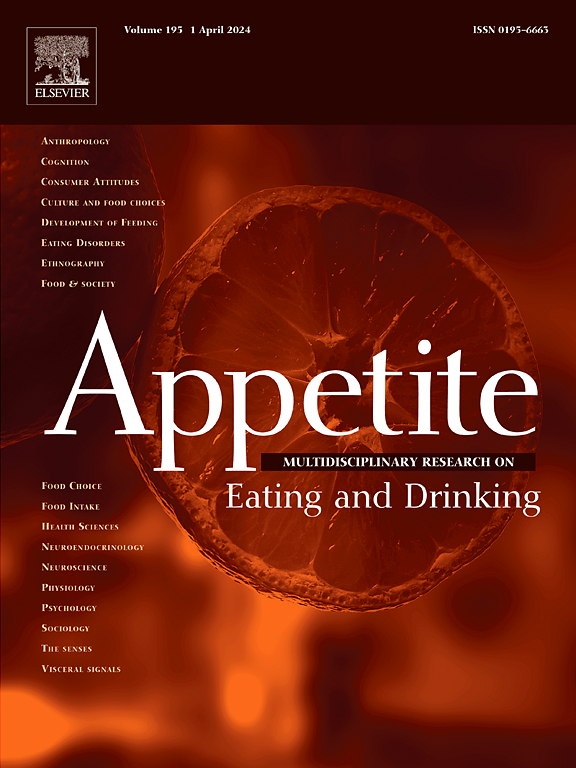The association between hunger-coping economic tradeoffs and food insecurity among female recipients of charitable food assistance
IF 4.6
2区 医学
Q1 BEHAVIORAL SCIENCES
引用次数: 0
Abstract
Food insecurity is an indicator of well-being in the United States. A high proportion of recipients of charitable food assistance (CFA) are women and are often in charge of specific household managerial responsibilities (e.g., childcare, transportation). Consequently, they frequently face choices between paying for food and paying for other basic need(s). This study aims to examine which hunger-coping economic tradeoffs place females with at least one dependent child in the house and females without a dependent child in the house at risk for experiencing food insecurity. Data was collected at 10 Houston-area and 10-Atlanta-area food pantries in 2022 (N = 883). Using USDA cutoff criteria, households were considered food insecure based on ≥3 affirmative responses to the 18-item Food Security Scale Module. Hunger-coping economic tradeoff experiences were based on affirmative responses to whether anyone in the household ever had to choose between food and six basic needs (i.e. childcare, medicine/medical care, utilities, rent/mortgage, transportation, education). Covariate-adjusted logistic regression models were conducted to understand the relationship between six hunger-coping economic tradeoffs and food insecurity for the entire analytic sample and stratified by whether the female participant had a child in house. Standard errors in all regression models were corrected to account for multiple observations within a pantry. Adults, on average, were 55 years old (58% food insecure; 47% Hispanic; 42% black). Four hunger-coping economic tradeoffs were related to experiencing food insecurity. Economic tradeoffs between food and a) medicine/medical care and b) transportation elevated the likelihood of food insecurity, regardless of child status. Tradeoffs between food and childcare increased the risk for experiencing food insecurity among females with a dependent child. Deciding to pay between food and utilities was related to food insecurity experiences among females without a dependent child. Increases in Supplemental Nutrition Assistance Program (SNAP) benefits and eligibility along with programs to enhance resources related to medical care, transportation, childcare and utilities could help reduce food insecurity, especially among CFA recipients.
在接受慈善粮食援助的女性中,应对饥饿的经济权衡与粮食不安全之间的关联。
在美国,粮食不安全是衡量福祉的一个指标。慈善食物援助(CFA)的很大一部分受助者是妇女,她们通常负责具体的家庭管理责任(如照顾孩子、接送孩子)。因此,她们经常要在支付食物和支付其他基本需求之间做出选择。本研究旨在探讨哪些应对饥饿的经济权衡措施会使家中至少有一个受抚养子女的女性和家中没有受抚养子女的女性面临粮食不安全的风险。研究于 2022 年在休斯顿地区和亚特兰大地区的 10 个食品储藏室收集了数据(样本数=883)。根据美国农业部的截止标准,对 18 项粮食安全量表模块的肯定回答≥3 次的家庭被视为粮食不安全家庭。应对饥饿的经济权衡经验基于家庭中是否有人曾不得不在食物和六种基本需求(即育儿、医药/医疗护理、水电、房租/抵押贷款、交通、教育)之间做出选择的肯定回答。我们对整个分析样本进行了协变量调整的逻辑回归模型,以了解六种应对饥饿的经济权衡与粮食不安全之间的关系,并根据女性参与者家中是否有孩子进行了分层。所有回归模型中的标准误差均已校正,以考虑到储藏室中的多个观测值。成人的平均年龄为 55 岁(58% 的人粮食不安全;47% 的人是西班牙裔;42% 的人是黑人)。四种应对饥饿的经济权衡方式与食物无保障的经历有关。在食物与 a) 药品/医疗护理和 b) 交通之间进行经济权衡会增加食物无保障的可能性,与儿童状况无关。在食物和儿童保育之间做出取舍会增加有受抚养子女的女性出现食物无保障的风险。在食品和水电费之间做出取舍与无受抚养子女女性的粮食不安全经历有关。提高补充营养援助计划(SNAP)的福利和资格,同时实施加强与医疗保健、交通、儿童保育和公用事业相关的资源的计划,可以帮助减少粮食不安全状况,尤其是在领取 CFA 的人群中。
本文章由计算机程序翻译,如有差异,请以英文原文为准。
求助全文
约1分钟内获得全文
求助全文
来源期刊

Appetite
医学-行为科学
CiteScore
9.10
自引率
11.10%
发文量
566
审稿时长
13.4 weeks
期刊介绍:
Appetite is an international research journal specializing in cultural, social, psychological, sensory and physiological influences on the selection and intake of foods and drinks. It covers normal and disordered eating and drinking and welcomes studies of both human and non-human animal behaviour toward food. Appetite publishes research reports, reviews and commentaries. Thematic special issues appear regularly. From time to time the journal carries abstracts from professional meetings. Submissions to Appetite are expected to be based primarily on observations directly related to the selection and intake of foods and drinks; papers that are primarily focused on topics such as nutrition or obesity will not be considered unless they specifically make a novel scientific contribution to the understanding of appetite in line with the journal's aims and scope.
 求助内容:
求助内容: 应助结果提醒方式:
应助结果提醒方式:


